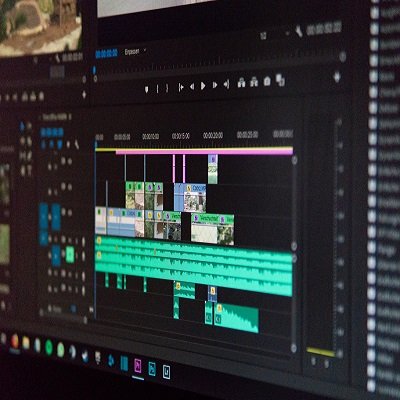Video Editing


Edit Videos like a Pro in 4 Weeks!
With the growth of digital video editing not just in Lagos but beyond Nigeria over the last few years, professional editing has become a must-have technology for any growing company or individual. Our video editing course with Adobe Premiere Pro covers all the fundamental and comprehensive methods, tools and techniques enabling you to get your message across fast with maximum impact using powerful, flexible editing capabilities.
This hands-on Adobe Premiere Pro training course will teach you to perform essential video editing functions, titles, and video and audio effects to a professional standard using Adobe Premiere Pro’s powerful advanced features. This Adobe Premiere Pro training course covers video hints and tips, project management issues and compression methods that can make all the difference to your final video production. You will work with dramatic real-world media to learn the practical techniques used daily in editing projects.
Course Outline
Introduction to Video Editing & Premiere Pro
- The Importance and Role of Video Editing
- An Overview of Adobe Premiere Pro and its industry use
Video Production Workflow
- An Overview of the Entire Workflow
- Shooting Footage – Tips and Techniques
- Getting a Feel for Non-Linear Editing
- Importing Assets – Getting Video and Files into a Computer
- Editing Video – What It Is All About
- Exporting Projects and Files – Sharing Your Finished Work
Getting Started with Premiere Pro
- Interface, Workspace and Panels
- Optimising Your Hardware
- Adjusting Premiere Pro Preferences and Other Settings
- Navigating and Customising the Workspace Your Workspace
- Customising Your Monitors
- How to Work With Monitor Overlays
- Starting and Opening Projects
Importing, Capturing & Managing Assets
- Moving Video Files from Camera to Computer
- Capturing Video from Tape
- Extracting Video Files from DVDs
- Importing Video and Other Assets
- Using the Media Browser to View and Import Assets
- Managing and Viewing Assets in the Project Panel
- Creating and Using Sub-Clips
- Using bins and metadata for organization
Basic Video Editing Techniques
- Creating a New Sequence
- Adding audio/video tracks
- Adding, Inserting and Arranging Clips in a Sequence
- Using Keyboard Modifiers When Editing a Sequence
- Detecting Duplicate Frames and Clips
- Creating and Using Sub-Clips
Advanced Editing
- Trimming Clips in Advance – Project Panel and
- Source Monitor
- Using the Trim Edit Tool
- Editing With the Ripple and Rolling Edit Tools
- Performing Slip, Slide and Split Edits
- Using the Trim Mode and Trim Monitor
- Adding Cutaways
- Editing Wide and Tight
- Using Markers to Create Matched-Action Edits
- Exporting and Creating Still Frames
- Changing Time – Slow, Fast and Reverse Motion
Adding Video And Audio Transitions
- Adding Video Transitions and editing Transition Properties
- Applying and Replacing Video Transitions
- Adjusting Video Transitions
- Using Some Specialized Transitions
- Applying and Adjusting Audio Transitions
- Checking Out Audio Effects
- Working With Channel-Oriented Effects
- Using Frequency and Pitch Control Effects
- Applying Delay-Oriented Effects
- Checking Out Noise Removal and Other Effects
Working with Video Effects
- Making Sense of the Numerous Video Effects
- Trying Out Some Video Effects
- Managing Video Effects
- Adjusting Effect Properties
- Animating Effects Using Key Frames
- Copying, Pasting and Moving Key Frames
- Adjusting Temporal Key Frame Interpolation
Performing Colour Correction and Grading
- Understanding the Colour Correction Workflow
- Organising Our Recommended Colour Correction Effects
- Working with Scopes
- Adjusting Tonality – Brightness and Contrast
- Adjusting Colour
- Using Secondary Colour Correction Techniques
- Using the Tint Effect
- Applying Lumetri Effect
Introducing Compositing And Layering
- Understanding How Compositing Works
- Layering Graphics, Video Clips and Backgrounds
- Working With Various Motion Effects on Composite Clips
- Using a Nested Sequence and the Picture-In-A-Picture Technique
- Creating a Looping, Animated Background
- Using Opacity and Blending Modes
- Working With Layered Photoshop Files
- Performing Multi-Camera Editing
- Taking a Look at Keying Effects
- Using the Key Effect
Specialized Compositing Methods
- Using Adjustment Layers
- Understanding the Track Matte Key Effect
- Highlighting Part of a Clip
- Importing or Adding Closed Captions to Projects
- Working with Nested Sequences
- Editing a Nested Sequence from the Source
Making Specialized Audio Edits
- Using Audio from One Clip on another Clip
- Making J- And L-Cut Audio Edits
- Normalising Audio and Making Sample-Level Edits
Title And Graphics
- The Importance of Supers
- Working Essential Graphics
- Starting With a Template
- Building Text from Scratch
- Using Text Styles
- Adding and Adjusting Text Properties
- Adding Graphics, Images, and Textures to Titles
- Making Text Roll or Crawl
- Creating Shapes and Using the Pen Tool
Using the Audio Track and Clip Mixer
- Working With the Audio Clip Mixer
- Controlling and Automating Track Volume And Panning
- Using Audio Effects in the Mixer
- Recording a Narration or Other Audio
- Outputting Tracks to Submit Tracks
Exporting a Project
- Understanding the Export Workflow
- Export Format Options
- Exporting a Sequence, Clip or Frame
Project, Mentorship And Assessment
- Instructors will review and grade the finished piece for their portfolio
- Final viewing party: Kick back, relax, and watch student reel

